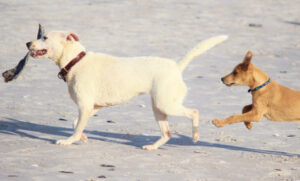When you have more than one dog, you might notice something strange happening: one dog biting the legs of another. It’s like a little mystery in the world of dogs. Why does dog bite other dogs legs? Is it just playing around, or is there something else going on?
Imagine this: You’re watching your dogs play in the backyard. They’re having a great time until one suddenly bites the other’s leg. It can be confusing, but don’t worry; we’re here to help you understand it.
So, get ready to explore the world of dog behavior with us. We’ll make it easy to understand, and by the end, you’ll better understand why your dog bites your other dog’s legs.
It’s like solving a fun puzzle that will bring you closer to your furry friends.
Is it Normal for Dogs to Bite Each Other’s Legs When Playing?
While playful biting is normal, dog owners must monitor the behavior to ensure it remains playful and doesn’t escalate into aggression.
Signs of friendly play include relaxed body language, wagging tails, and play bows (when a dog lowers their front end while keeping their hind end elevated.
If the biting becomes too rough or one dog appears uncomfortable or distressed, it’s a good idea to intervene and redirect their attention to a different activity or provide a short break.

Common Reasons Behind Leg Biting
Now that we’re trying to figure out why dogs bite each other’s legs, let’s explore some common reasons behind this behavior.
a. Behavior of a Specific Dog Breed
Sometimes, the way a dog behaves and bites another dog’s legs is connected to its breed. Different kinds of dogs have different habits because of how people bred them long ago.
For instance, some dogs, like Border Collies, were bred to be good at herding animals. So, they might try to nip at other dogs’ legs, thinking they’re herding them. It’s like a job they were born to do.
Other dogs, like terriers, were bred to hunt, and they can be more aggressive. So, sometimes they might act a bit tough, and they might even bite other dogs’ legs when they play.
Knowing what kind of dog you have can give you clues about why they bite other dogs’ legs. But keep in mind, not all dogs act exactly like what people say about their breed. Every dog habit is different!
b. Aggression
Sometimes, when one dog bites another’s legs, it’s not a game – it’s because they’re mad or scared. This is called aggression. It happens when dogs get angry or want to protect their things, like food or toys.
If you see a dog biting another’s legs and it looks serious – like they’re growling or trying to hurt the other dog – that’s aggression. It’s important to stop this behavior and get help from a dog expert because it can be dangerous.
But if the dogs are just playing and nipping gently, that’s not aggression. That’s how dogs have fun sometimes.
c. Lack of Socialization
Socialization means that a dog learns how to be friendly and nice around other dogs and people. If a dog didn’t get a chance to do this when they were young, they might not know how to act around other dogs.
So, if a dog didn’t meet other dogs and learn how to play nicely when they were a puppy, they might act strangely, like biting other dogs’ legs. It’s not because they’re mean, it’s because they didn’t learn how to behave.
d. Communication
Dogs use their mouths to communicate with each other, and biting can be a way of conveying various messages.
When a dog bites another dog’s legs gently, it could be a sign of asserting dominance or establishing their rank in the pack.
This type of biting is usually accompanied by other body language cues, such as body posture and facial expressions.
e. Attention-Seeking
Sometimes, a dog may bite another dog’s legs to gain attention or playtime. It’s their way of saying, “Hey, let’s do something fun together!” This is typically harmless and may indicate that your dogs enjoy each other’s company.

What to Do When Dogs Bite Each Other’s Legs:
When you witness dogs biting each other’s legs, it’s essential to react calmly and responsibly to ensure the safety and well-being of all involved. Here’s a user-friendly guide on what to do in such situations:
1. Distract and Redirect
When you witness your dog biting another dog, swift action can help defuse the situation. Reach for their favorite toy or treat and enthusiastically call their name. This redirects their focus and interrupts the behavior. Reinforce positive behavior with rewards, showing them that calm and friendly interactions are encouraged.
2. Assess the Situation
Maintaining your composure is vital. Assess the scene carefully to ensure everyone’s safety. Check for any injuries on both dogs and people involved. Stay calm to prevent escalating tension and to effectively manage the situation.
3. Muzzle If Necessary
If your dog displays aggressive tendencies or poses a risk of biting, consider using a muzzle. Choose a comfortable, well-fitting muzzle designed for dogs.
It’s a safety measure that can protect both your dog and others in potentially stressful situations.
4. Monitor for Signs of Infection:
After a dog bite incident, keep a close watch for signs of infection in the affected areas. Look for redness, swelling, or discharge.
If you spot these symptoms, consult a veterinarian promptly to address potential health concerns.
5. Visit the Vet:
If dog-on-dog biting persists or results in injuries, a visit to the vet is essential.
Veterinary professionals can assess the situation, provide necessary medical care, and offer guidance on managing behavior to prevent future incidents. Early intervention can lead to a safer and more harmonious environment for your dogs.
Conclusion:
In most cases, dogs biting each other’s legs is a natural part of their social interaction and play.
Understanding the reasons behind this behavior can help you determine whether it’s harmless play or something that requires your intervention.
By monitoring their interactions, providing proper training, and seeking professional guidance when needed, you can ensure a happy and harmonious relationship among your canine companions.

